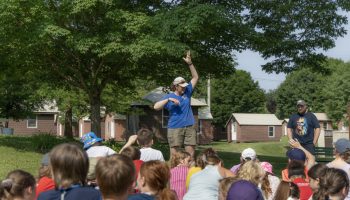Mentioning algae or algal blooms around Chautauqua Lake might drive people to take up torches and pitchforks in the vein of Frankenstein. Courtney Wigdahl-Perry, assistant professor of biology at SUNY Fredonia, will douse these torches as she helps show both sides of these microscopic organisms vital to the lake’s entire ecosystem.
Wigdahl-Perry will host a Bird, Tree & Garden Club Lake Walk, “Lakeside Lab — Exploring Chautauqua Lake’s Underwater Life,” at 6:30 p.m. Monday, July 30, starting at the lakeside porch of the Youth Activities Center. Wigdahl-Perry will show how algae species provide the base upon which the entire lake’s life cycle depends and balances. After she provides background information, Wigdahl-Perry said participants will be able to see the organisms up close through microscopes to observe them on an intimate level.
“Without algae, you really wouldn’t have anything else in the lake,” Wigdahl-Perry said. “They really feed everything all the way up through fish.”
Wigdahl-Perry first became involved in the subject of constantly changing microscopic organisms while taking part in a lake management project as an undergraduate student at University of Wisconsin-La Crosse.
Wigdahl-Perry received her Ph.D. in ecology and environmental science at the University of Maine. She is in her fifth year teaching at SUNY Fredonia.
Working around Chautauqua Lake is very complicated, Wigdahl-Perry said, because of its two completely different basins and complex watershed.
“From a research perspective, it’s all very interesting,” Wigdahl-Perry said. “It’s also really been wonderful to work in a place where people care so deeply about the lake. It’s really easy to get tangled in the politics, but it’s nice to take a step back and look at the community effort to work toward a solution.”
Wigdahl-Perry said she has been told that if she can give people the solution to “fix the lake,” they’d give her millions to get it done. However, Wigdahl-Perry said there’s no “silver bullet” solution — that’s just not how it works. She said she’s not formally trained in lake management, but she knows algae.
“We’re not talking about just one particular species; we’re talking about hundreds of different types of algae at the base of this food network that are interacting with each other, water conditions, and things that eat them all the time,” Wigdahl-Perry said. “There’s not a clean answer all the time. We just have to sit back and watch the info.”
The main cause of algae’s bad name around the lake is the algal blooms prominent at various points each year. Wigdahl-Perry said despite an increasing push to find an answer to these blooms that are affecting numerous aspects of community livelihood, there has been no trend in increasing frequency over the last 30 years.
“It’s a healthy system,” Wigdahl-Perry said. “There’s a lot that’s really good about (the lake). The blooms are bad, but it’s relatively normal compared to similar bodies elsewhere.”
The question of the blooms is not one unique to Chautauqua, with researchers looking for answers all around the world. Although Chautauqua Lake is not an outlier, relative to similar lakes elsewhere, there are still significant problems presented, Wigdahl-Perry said. In addition to the toxicity and putrid odors the blooms emit, the algae present problems to the species that consume them.
“When you mess with the base of the food web, that has ramifications going up the line,” Wigdahl-Perry said.
Die-offs of the blooms present another set of issues. As organisms die and are broken down by bacteria, oxygen is used up, producing low-oxygen concentrations in deeper areas of the lake, Wigdahl-Perry said. Low oxygen concentrations can lead to a fluctuation in fish populations, eventually resulting in large-scale fish death in some cases.
Wigdahl-Perry said biologists are working to better figure out differences in algae from year to year to better develop models and understand bloom patterns. With no easy short-term answers to blooms that won’t deplete the lake of key organisms, Wigdahl-Perry said the answer becomes a balance between short-term actions and long-term solutions.
Wigdahl-Perry said the questions she gets at the Institution always keep her on her toes, as people want to be involved and continue to learn.
“They are very thoughtful and very interested in what’s happening,” Wigdahl-Perry said. “There’s visitors and residents, but they’re all hanging out around this lake, and they want to know more.”





